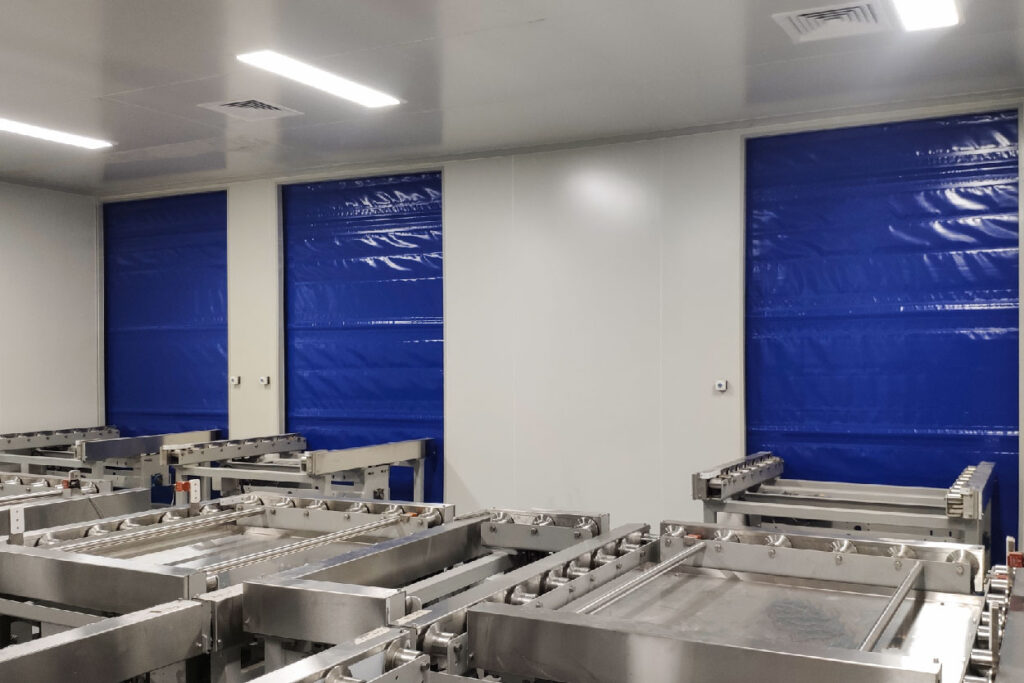What is an Insulated Roller Door? Why is it widely used in industrial settings?
An insulated roller door, commonly referred to in Chinese as an insulated roller door, is an industrial door system that combines high-speed opening and closing performance with a thermal insulation structure. It is specifically designed for scenarios with strict requirements for temperature control, energy consumption management, and production rhythm.
Unlike ordinary PVC rapid doors, its door curtain is a composite structure, typically consisting of multiple layers of materials, such as:
An outer layer of wear-resistant, scratch-resistant, and easy-to-clean high-strength PVC;
An insulating core layer (such as foam, EVA, XPS, etc.) or double-layer aluminum alloy;
Multiple sealing strips along the edges to prevent heat exchange.
This type of product is particularly suitable for applications such as food cold chains, electronics manufacturing, cleanrooms, temperature-controlled warehouses, and pharmaceutical factories.
Real-life case study: Customized application of insulated rapid doors in refrigerated logistics channels

Project overview
Project type: Separation of refrigerated and ambient temperature logistics channels in a food company
Door opening dimensions: W3000mm × H3500mm
Usage Frequency: ≥500 openings per day
Core Requirements:
Prevent exchange of hot and cold air
Quick opening and closing of the door to reduce energy loss
Safety anti-pinch feature and compatibility with forklift passage
Ensure efficient operation of the cold chain logistics system
Technical Specifications
| Configuration items | Description |
| Door curtain structure | Double-layer high-density PVC + intermediate foam insulation layer, thickness 20 mm |
| Guide rail system | Insulated aluminum alloy guide rails + EPDM sealing strips + heating wire system (optional) |
| Drive method | Industrial variable frequency motor + PLC intelligent control system |
| Opening speed | 0.8–1.2 m/s (adjustable) |
| Safety device | Bottom flexible anti-collision safety edge + dual-side infrared photoelectric sensors |
| Service life | ≥500,000 opening/closing cycles |
Implementation Results
Significant reduction in air convection before entering the cold storage, with more stable temperature maintenance.
Energy consumption decreased by 18.6% year-on-year, with faster door closing response.
Smoother passage for workers and forklifts, with no mis-touch or vehicle entrapment accidents.
The door curtain structure is sturdy, with thermal insulation performance maintaining ±0.5℃ environmental temperature difference control.
Core Technical Advantages of Insulated Roller Doors
1. Superior thermal insulation performance
As a result of its design, the multi-layer composite structure achieves a thermal conductivity coefficient of ≥0.4W/m²·K, effectively preventing the exchange of cold and warm air and reducing the load on the cooling system.
2. Rapid Opening/Closing for Enhanced Efficiency
Integrated with a servo system and limit switch logic, the entire door can fully open within 1 second, accommodating high-paced logistics, AGV traffic, and other automated production requirements.
3. Comprehensive Sealing Design
The perimeter tracks use EPDM rubber strips, the bottom employs flexible airbags that tightly seal against the door frame, and the top roller shutter slot provides additional sealing, achieving full-area airtight separation.
4. Modular System for Easy Maintenance
The door curtain, drive system, control system, and sensors can be replaced individually, resulting in low operational failure rates, short maintenance times, and minimal disruption to the factory’s overall production schedule.
Applicable industries and typical application scenarios
| Application Industries | Application Areas | Target Value |
| Food Processing/Cold Chain Warehouses | Cold storage doors / Logistics entrances and exits | Insulation, energy saving, anti-condensation, anti-cold bridge |
| Precision Electronics Manufacturing | Constant temperature clean areas / Machine rooms / SMT production line partitions | Temperature control, dust prevention, anti-static |
| Medical and Pharmaceutical Factories | Filling workshops / Inspection rooms / Passageway entrances | Clean control, anti-cross contamination, temperature balance control |
| Commercial Cold Chain Supermarkets | Entrances and exits for frozen goods backyards | Energy saving and noise reduction, intelligent sensing passage, safety anti-pinch |
Insulated Roller Door Compared to Other Types of Industrial Doors

| Performance Dimensions | Insulated Roller Door | Standard high-speed door | Industrial Sectional Doors |
| Thermal Insulation Performance | ⭐⭐⭐⭐ (Core Advantages) | ⭐ | ⭐⭐⭐ (Strong static sealing) |
| Opening and Closing Speed | ⭐⭐⭐⭐ | ⭐⭐⭐⭐ | ⭐⭐ |
| Structural Compatibility | ⭐⭐⭐ | ⭐⭐⭐⭐ | ⭐⭐ |
| Service Life | ⭐⭐⭐⭐ (≥500,000 times) | ⭐⭐⭐ | ⭐⭐⭐ |
| Initial Investment | ⭐⭐⭐ | ⭐⭐ | ⭐⭐⭐ |
Selection Recommendations and Maintenance Tips
Selection Recommendations
Determine the door opening size, daily opening and closing frequency, and traffic type (people, forklifts, AGVs, etc.).
Determine the temperature range and humidity of the application area to decide whether a heating and defrosting system is required.
Pay attention to the thickness of the door curtain (usually ≥15 mm for thermal insulation) and the track sealing structure.
Select products with CE/ISO/FDA compliance certification to meet the requirements of food or pharmaceutical factories.
Maintenance Points
Check the wear and tear of the door curtain and the condition of the guide rail seal strip every month.
Test the sensitivity of the sensor device (photoelectric/radar) every quarter and calibrate it in a timely manner.
If used in a high-humidity environment, it is recommended to add a heating wire to prevent condensation and ice buildup on the guide rail.
It is recommended to check the parameter operating status and emergency stop feedback function of the control system every six months.
FAQ (Concise Version)
Q1: Can insulated roller doors be used in sub-zero environments?
✅ They can be used in cold storage facilities and, when equipped with a heating system, are suitable for areas below -20°C.
Q2: Which type of door provides better insulation compared to a sliding door?
✅ Sliding doors offer better static insulation, while insulated roller doors are more suitable for scenarios with frequent opening and closing, providing higher dynamic insulation efficiency.
Q3: Does it support remote control or access control integration?
✅ Supports PLC interface integration, including barcode scanners, radar, ground magnetic sensors, and AGV scheduling

